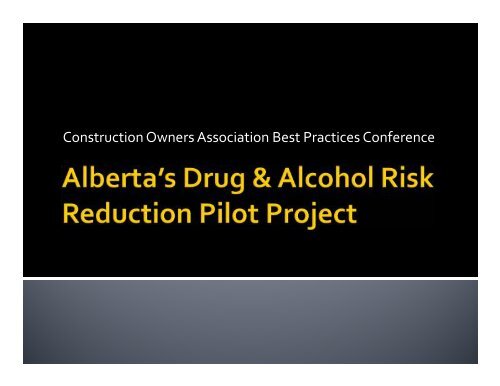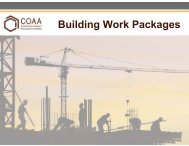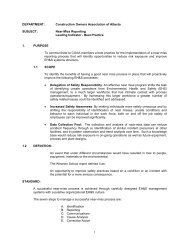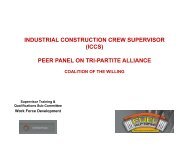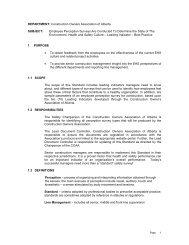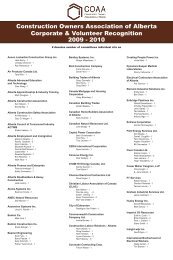DARRPP Co. Rollout - Construction Owners Association of Alberta
DARRPP Co. Rollout - Construction Owners Association of Alberta
DARRPP Co. Rollout - Construction Owners Association of Alberta
- No tags were found...
Create successful ePaper yourself
Turn your PDF publications into a flip-book with our unique Google optimized e-Paper software.
<strong>Co</strong>nstruction <strong>Owners</strong> <strong>Association</strong> Best Practices <strong>Co</strong>nference
BackgroundEligibility for pilotCurrent statusApplication processImplementationNext stepsQuestions<strong>Co</strong>nfidential COAA May 16, 2012 2
<strong>DARRPP</strong> began as a working group with representatives fromgovernment, industry, labourIntent was to address confusion resulting from Human Rights, Privacy,and Safety requirementsSeveral years <strong>of</strong> work occurred resulting in <strong>DARRPP</strong>, which has beendesigned to address safety concerns, while complying with HumanRights and Privacy requirements<strong>DARRPP</strong> is a best practices A&D model, which includes:A&D testing including random testing for safety sensitive positionsA medical assessment modelCase management, follow-up and return to work provisions<strong>Co</strong>nfidential COAA May 16, 2012 3
Organizations in oil sands operations and heavy industrial constructionand maintenance industries may participate in the pilotThis includes owner companies, contractors and labour organizationsOrganizations that have applied the Canadian Model or similar policiesshould be well positioned to participate in the pilot project<strong>Co</strong>sts for pilot handled on a cost sharing basis<strong>Co</strong>nfidential COAA May 16, 2012 4
5 information sessions have been held between Dec 2011-April 2012,with about 200 attendeesCurrently working with a group <strong>of</strong> owners on implementation strategiesAnticipate owner announcements <strong>of</strong> participation in June, withimplementation staged over the 3& 4Q 2012<strong>Owners</strong> will expect contractors to implement a similar programExtensive, detailed communication plan and tools have been developedand will be available to all participating organizations<strong>Co</strong>nfidential COAA May 16, 2012 5
Fill in on-line application form, located on <strong>DARRPP</strong> websiteWill be reviewed by <strong>DARRPP</strong> Administrator (can be one application formultiple organizations provided program is common)Purpose <strong>of</strong> application form is:to ensure pilot participants have policies and processes in place that areconsistent with the practices identified in the <strong>DARRPP</strong> principles andguidance documentsso that there is basic consistency in process among pilot participants t<strong>of</strong>acilitate data collection and evaluation processes<strong>Co</strong>nfidential COAA May 16, 2012 6
Evaluations will be prepared for completion in July 2013 and July 2014and will be shared with government and participants <strong>of</strong> the pilot projectEvaluations will consist <strong>of</strong> a report which includes:Analysis <strong>of</strong> data submitted by all participants in the pilotSummaries <strong>of</strong> organizations key progress, learning's and challengesThe audit process is still being developed but an audit will be conductedby an external auditor to ensure robust programs and practices are inplace, which are consistent with best practices as per <strong>DARRPP</strong><strong>Co</strong>nfidential COAA May 16, 2012 7
Some sites are likely to implement a centralized “site” testing model, forrandom testing which can be used by contractors, potentially using datafrom the swipe card systemThird party testing provider would arrive at the site on a periodic basisNames <strong>of</strong> workers in safety sensitive positions (at work that shift) would begenerated from the swipe card system and a random list drawnThe TPA would administer A&D tests, and processes would be followed as perthe COAA model, including lab processing, MRO review, SAE assessment,case management, treatment, follow-upTesting results would go only to the contractor or case manager, not to theowner<strong>Co</strong>nfidential COAA May 16, 2012 8
Another options being considered is that each contractor would maketheir own arrangements for random testing <strong>of</strong> their workers<strong>Co</strong>ntractors would then need to:Make arrangements with a testing TPA, as well as SAE, case management,EAP, etc.▪▪▪Provide a list <strong>of</strong> names <strong>of</strong> workers in safety sensitive positions, along with contactinfo, site working at, etc.Set up a schedule for testing with the testing TPATesting would be administered as per COAA standards and all other processes wouldoccur such as lab testing, MRO, SAE assessment, case management, follow-up, etc.<strong>Co</strong>nfidential COAA May 16, 2012 9
Will also need to:Apply for the pilot – application will be on <strong>DARRPP</strong> websiteUpdate policy – if not using COAADetermine which workers are in safety sensitive positions<strong>Co</strong>mmunicate changes to workersTrain supervisorsGear up your infrastructure – EAP, etcHave a mechanism in place to provide necessary data<strong>Co</strong>nfidential COAA May 16, 2012 10
<strong>Co</strong>mmunication plan & package for participants being finalized forimplementation in 2Q 2012Extensive package will be provided to participants including:▪▪▪Press release, video, brochure for employees, PowerPoint overview, media contactplan, tool box talks based on interviews from experts, posters & stickers availableWeb site being set up for communications documents, <strong>DARRPP</strong> documents,application process and data collectionTheme is “Good to Go”<strong>Co</strong>mpanies will apply for pilot, finalize policies and plans and likely implementin 3Q, 2012; contractors likely to implement late fall 2012<strong>Co</strong>nfidential COAA May 16, 201211
What would assist contractors in being ready to implement this pilot?Are workshops needed on how to implement random testing?Would a centralized, site based testing process work for yourorganization or would it be better for each contractor to set up their owntesting process?What else would be useful or helpful?<strong>Co</strong>nfidential COAA May 16, 2012 12
<strong>Co</strong>nfidential COAA May 16, 2012 13
<strong>Co</strong>nfidential COAA May 16, 2012 14
<strong>Co</strong>nfidential COAA May 16, 2012 15
<strong>Co</strong>nfidential COAA May 16, 2012 16
<strong>Co</strong>nfidential COAA May 16, 2012 17
Opportunity to take proactive action re: safetyPotential for serious incidents/fatalitiesRandom testing is an effective deterrent▪ Federal Transit Administration random testing stats 1995-2008▪ Alcohol 1995 .25% positive; in 2008 down to .15%▪ Drugs 1995 1.76% positive; in 2008 down to .82%▪In <strong>Alberta</strong> heavy industry, alcohol & drug testing positive rates are generally muchhigher then the FTA’s 1995 rates so considerable room for improvement▪ 2010 site access failure rates 2.5 – 5%; post incident 5 – 10%; reasonable cause 30-65%<strong>Co</strong>nfidential COAA May 16, 2012 18
Random testing is an effective deterrent cont’d:Random testing in <strong>Alberta</strong>:▪1996 positive rate 2.08, 2010 down to .87 (similar to FTA stats)US random alcohol testing data among motor coach drivers▪1995 mandatory alcohol testing implemented for motor coach drivers (also hadoverall testing program)▪ As <strong>of</strong> 2006, prevalence <strong>of</strong> alcohol involvement in fatal crashes decreased by 80%<strong>Co</strong>nfidential COAA May 16, 2012 19
In 2007 serious incident – “Lytton subway work car fatality” – operator <strong>of</strong>work car had measureable levels <strong>of</strong> THC in his system – level indicateddrug likely used during his shift – operator killed, two crew membersseriously injured, other crew members traumatized – lengthy absencesIn 2008, TTC staff recommended changes to Fitness for duty policyincluding random testing – approved by the commission except forrandom testingIn 2010, policy changes were implementedAugust, 2011 bus crash killed a passenger; in Oct, police charged thedriver with criminal negligence causing death & possession <strong>of</strong> cannabisOne week later, Oct 19, 2011 TTC announced random testing wasapproved by the <strong>Co</strong>mmission for implementation<strong>Co</strong>nfidential COAA May 16, 2012 20
Implement a comprehensive A&D program that includes the following:Random testing in addition to the testing program already in place in yourorganizationAn A&D program that meets or exceeds the standards <strong>of</strong> the Canadian Modeland complies with the <strong>DARRPP</strong> guidance and/or principles documentA medical model for assessment, treatment, case management<strong>Co</strong>mmitment to adhering to all relevant legal requirements associated withthe implementation and administration <strong>of</strong> an A&D program including:▪▪<strong>Co</strong>mpliance with Human Rights legislation regarding workers assessed as having adisability<strong>Co</strong>mpliance with Privacy Legislation regarding the A&D testing process and accessto A&D related information<strong>Co</strong>nfidential COAA May 16, 2012 21
<strong>Co</strong>mprehensive A&D program cont’d:A program tied to defensible standards tailored to the environment in whichthe testing will occurLimit random testing to positions defined as safety sensitive and demonstratea reasonable approach in this evaluation process<strong>Co</strong>nfidential COAA May 16, 2012 22
Workers who test positive must be assessed, and if dependant, must be<strong>of</strong>fered treatment, rehabilitation, return to work similar to employeeswith other disabilitiesWorkers who test positive and who do not have a disability may be<strong>of</strong>fered treatment and/or handled through the organizations disciplineprocessesThe Human Rights <strong>Co</strong>mmission has confirmed that they are not involvedin:whether and when A&D testing is doneHow positive test results are handled by organizations when the worker isassessed as not being dependent<strong>Co</strong>nfidential COAA May 16, 2012 23
A&D testing data, including names <strong>of</strong> those tested, results, etc. must beprotected. Examples <strong>of</strong> potential issues are:Owner companies having data or requesting data or taking action regardingcontractor workersSharing lists or names <strong>of</strong> “inactive” workers or workers who have had positivetests between owner companies or owners and contractors<strong>Co</strong>nfidential COAA May 16, 2012 24


